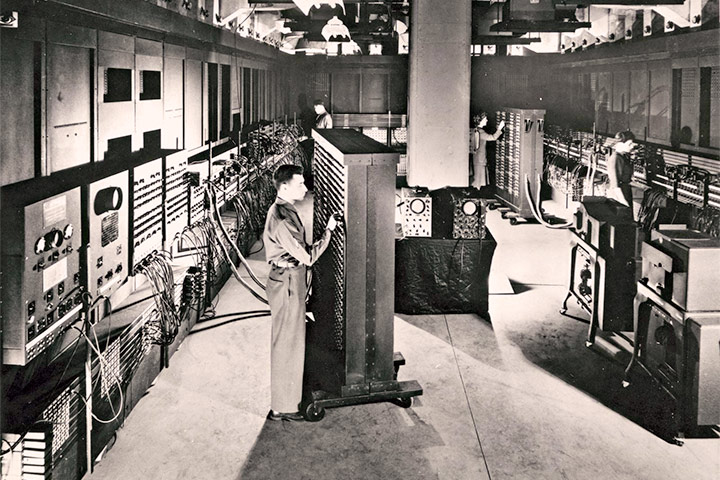I just found out that computers existed… before computers existed.
And they were women.
I’m interested in computers (and women) because they seem to be everywhere, nowadays. In people’s pockets, when you’re checking out at the grocery store, pretty much everywhere. (I mean, the computers. Women are also in the grocery store, but not in people’s pockets.)
Not only am I interested in the ubiquity of computers… I’m also concerned about the future of humankind. Perhaps two different things.
As I recently found out, the first ‘general purpose’ electronic computer — the ENIAC (“Electronic Numerical Integrator And Computer”) — was built at the University of Pennsylvania in 1945.
The aim was to replace the existing computers… who were women.
During the Second World War, things had become complicated. In the good old days of warfare, a soldier had considerable control over who he was killing, because he had to physically stick his spear or sword into a person who was, at the same time, trying to stick a spear or sword into the soldier in question. This didn’t necessarily prevent innocent (non-soldier) citizens from getting killed, because, as a famous general once said, “War is hell.”
But historically speaking — back in the good old days — not many innocent bystanders were killed in wars.
That situation had changed dramatically by 1939, as the Second World War kicked off. Scientists and engineers had invented a whole hodgepodge of exciting new weapons — bombs and artillery and missiles — that could kill people over long distances. From many miles away, or from thousands of feet in the air.
But although the new weapons were extremely deadly, they weren’t necessarily all that accurate.
Enter, the ‘computers’.
The computers were women armed with slide rules and maps and adding machines, and logarithmic tables. Thus the name, “computers”. Because they were workers who computed.
The job of the computers — who were brilliant (but underpaid) trained mathematicians — was to compute the most accurate trajectories for those messy, long-range weapons, so they didn’t kill innocent civilians, unnecessarily.
The idea of hiring human computers started with astronomers, who were trying to predict the paths of planets and comets and asteroids and such… but the calculations were so complicated, that they finally figured out how to break the job into bite-size pieces, and hire gangs of people to solve the formulas. It required precision, and an ability to work for long hours. Originally, the computers were young men, fresh out of college. (Not the type of person known for a tendency to work long hours.)
Gradually, the scientists realized that hiring women would reduce the cost of computation, because women — with fewer job options — could be paid half of what men got. And be happy to have the job.
It’s actually not much fun in being an astronomer; having a gang of young women to boss around was one of the few perks.
By 1939, the military had adopted the practice of hiring brilliant (but underpaid) women as computers. But the war in Europe and the Pacific was not going all that smoothly for the U.S. military, so someone had the bright idea of building an electronic ‘computer’. The benefits were obvious. A single electronic computer could do the work of a whole roomful of women, and it didn’t gossip, or take lunch breaks.
Also, an electronic computer didn’t provide as many temptations, if the colonel in charge was unhappily married.
So many reasons to go electronic.
The ENIAC was monstrously huge, by modern standards, containing 18,000 vacuum tubes, 7,200 crystal diodes, 1,500 relays, 70,000 resistors, 10,000 capacitors, and approximately 5 million hand-soldered joints. It weighed more than 27 tons and occupied 1,800 sq ft.
The new computer was not completed until after the end of World War II, which was a disappointment to many people.
Not to be discouraged, the U.S. military hired a gang of women to program the ENIAC, and then used the machine to help design the first hydrogen bomb.
Obviously, the idea of preventing indiscriminate civilian deaths had somehow been tossed out the window. The idea now was to kill as many civilians as possible.
Many things have changed since 1945. For one thing, scientists invented the silicon chip, which replaced the transistors used in computers (after transistors replaced vacuum tubes). In 1995, the University of Pennsylvania celebrated ENIAC’s 50th anniversary by fitting the computational power of the 27-ton ENIAC onto a chip smaller than a dime.
80 years later, we’re carrying computers in our pockets.
Which suggests that anyone with an iPhone could design their own hydrogen bomb, if they wanted to take the time.
But fortunately, we’d rather share silly memes on social media.
Which gives me hope for the future.
Underrated writer Louis Cannon grew up in the vast American West, although his ex-wife, given the slightest opportunity, will deny that he ever grew up at all. You can read more stories on his Substack account.





